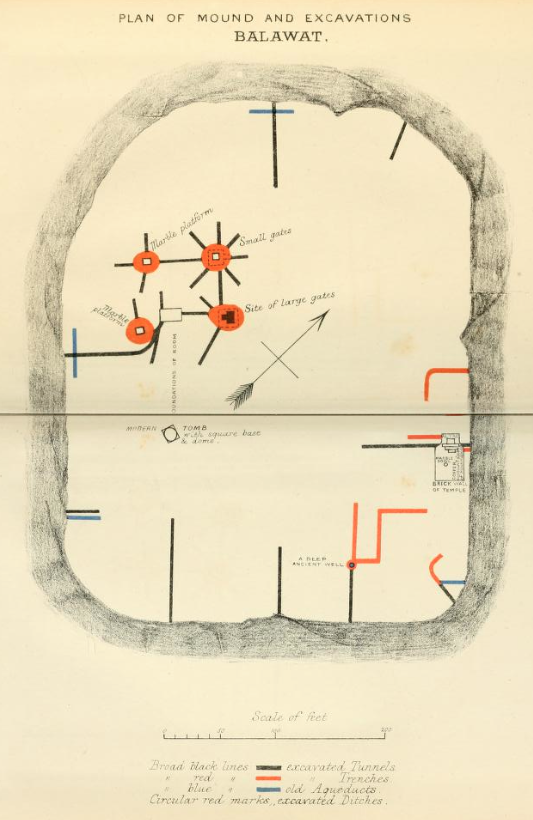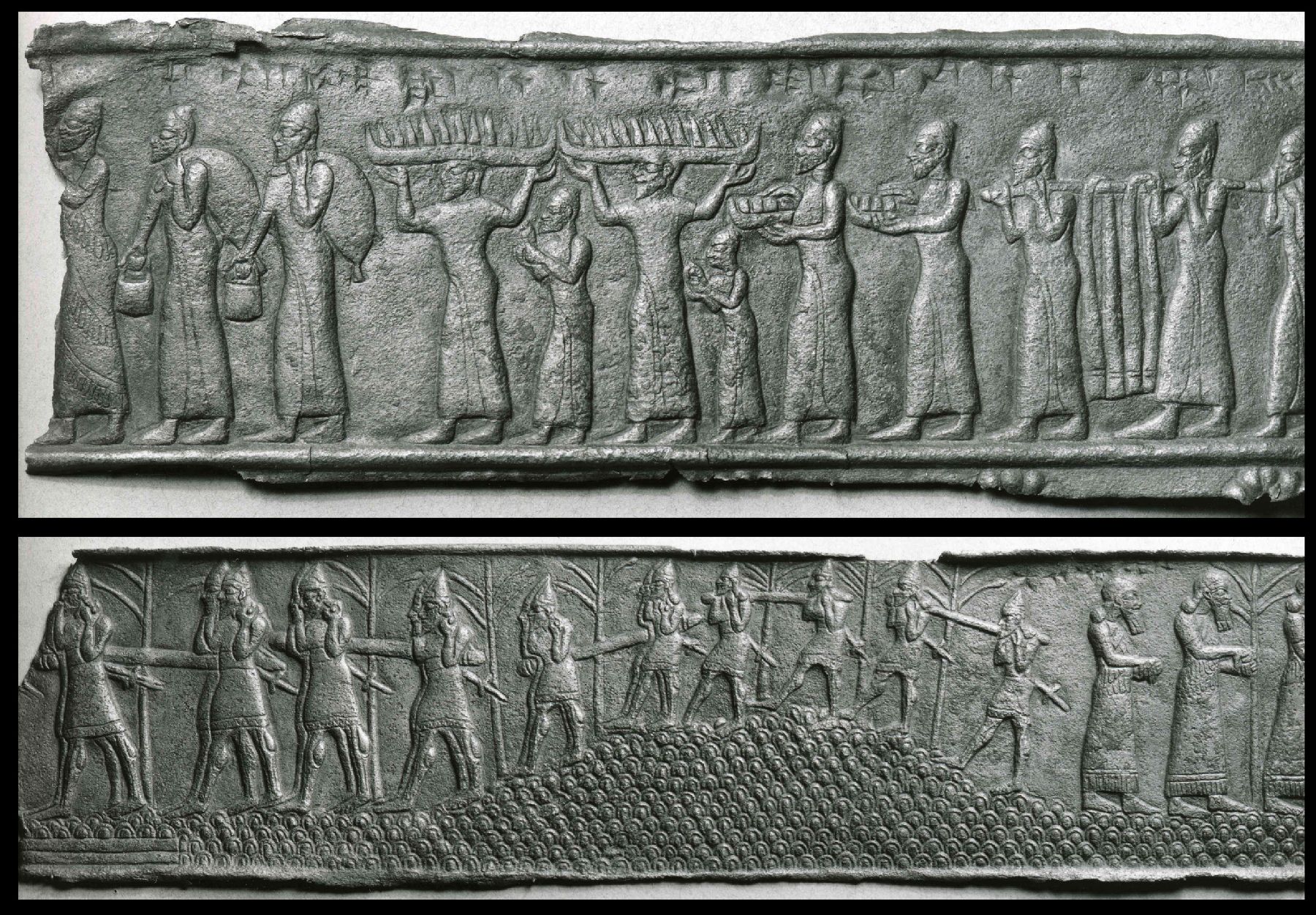Balawat on:
[Wikipedia]
[Google]
[Amazon]
Balawat ( syc, ܒܝܬ ܠܒܬ, ') is an
 The site was excavated in 1878 by archaeologist
The site was excavated in 1878 by archaeologist
 Aside from temples and palace buildings, the most important artifacts discovered there were the so-called
Aside from temples and palace buildings, the most important artifacts discovered there were the so-called
Theophilus G Pinches and Walter de Gray Birch, The bronze ornaments of the palace gates of Balawat (Shalmaneser II, B.C. 859-825) edited, with an introduction by Walter de Gray Birch ; with descriptions and translations by Theophilus G. Pinches, Society of Great Russell Street, 1902 *Seton Lloyd, Foundations in the Dust, 1947 *J.E. Curtis et al., The Balawat Gates of Ashurnasirpal II, British Museum Press, 2008, *Léonard W. King, Bronze Reliefs from the Gates of Shalmanezer. King of Assyria BC 860-825, Longman's & Company, 1915
Bronze relief fragment at the Walters Art Museum
{{Authority control Populated places in Nineveh Governorate Archaeological sites in Iraq Ancient Assyrian cities Tells (archaeology) Assyrian communities in Iraq
archaeological site
An archaeological site is a place (or group of physical sites) in which evidence of past activity is preserved (either prehistoric or historic or contemporary), and which has been, or may be, investigated using the discipline of archaeology an ...
of the ancient Assyrian city of Imgur-Enlil, and modern village in Nineveh Province
Nineveh Governorate ( ar, محافظة نينوى, syr, ܗܘܦܪܟܝܐ ܕܢܝܢܘܐ, Hoparkiya d’Ninwe, ckb, پارێزگای نەینەوا, Parêzgeha Neynewa), also known as Ninawa Governorate, is a governorate in northern Iraq. It has an ...
(Iraq
Iraq,; ku, عێراق, translit=Êraq officially the Republic of Iraq, '; ku, کۆماری عێراق, translit=Komarî Êraq is a country in Western Asia. It is bordered by Turkey to Iraq–Turkey border, the north, Iran to Iran–Iraq ...
). It lies southeast from the city of Mosul
Mosul ( ar, الموصل, al-Mawṣil, ku, مووسڵ, translit=Mûsil, Turkish: ''Musul'', syr, ܡܘܨܠ, Māwṣil) is a major city in northern Iraq, serving as the capital of Nineveh Governorate. The city is considered the second larg ...
and to the south of the modern Assyrian
Assyrian may refer to:
* Assyrian people, the indigenous ethnic group of Mesopotamia.
* Assyria, a major Mesopotamian kingdom and empire.
** Early Assyrian Period
** Old Assyrian Period
** Middle Assyrian Empire
** Neo-Assyrian Empire
* Assyri ...
town of Bakhdida
Qaraqosh, also known as Al-Hamdaniya or Bakhdida, is an Assyrian city in Iraq within the Nineveh Governorate, located about 32 km (20 mi) southeast of the city of Mosul and 60 km (37 mi) west of Erbil amid agricultural lands, close ...
.
Ancient name
Balawat is the site of the ancientAssyria
Assyria ( Neo-Assyrian cuneiform: , romanized: ''māt Aššur''; syc, ܐܬܘܪ, ʾāthor) was a major ancient Mesopotamian civilization which existed as a city-state at times controlling regional territories in the indigenous lands of the A ...
n city of Imgur-Enlil. The meaning of Imgur-Enlil is "Enlil agreed". Note that there was also a wall in ancient Babylon
''Bābili(m)''
* sux, 𒆍𒀭𒊏𒆠
* arc, 𐡁𐡁𐡋 ''Bāḇel''
* syc, ܒܒܠ ''Bāḇel''
* grc-gre, Βαβυλών ''Babylṓn''
* he, בָּבֶל ''Bāvel''
* peo, 𐎲𐎠𐎲𐎡𐎽𐎢 ''Bābiru''
* elx, 𒀸𒁀𒉿𒇷 ''Babi ...
named Imgur-Enlil.
History of archaeological research
 The site was excavated in 1878 by archaeologist
The site was excavated in 1878 by archaeologist Hormuzd Rassam
Hormuzd Rassam ( ar, هرمز رسام; syr, ܗܪܡܙܕ ܪܣܐܡ; 182616 September 1910), was an Assyriologist and author.
He is known for making a number of important archaeological discoveries from 1877 to 1882, including the clay tablets tha ...
. The site was again excavated by Max Mallowan for the British School of Archaeology in Iraq in 1956. A surface survey was conducted by D. J. Tucker in 1989 for the British Museum. The town walls enclosed an area of around 64 hectares.
Occupation history
The city of Imgur-Enlil was founded by the Neo-Assyrian kingAshurnasirpal II
Ashur-nasir-pal II ( transliteration: ''Aššur-nāṣir-apli'', meaning " Ashur is guardian of the heir") was king of Assyria from 883 to 859 BC.
Ashurnasirpal II succeeded his father, Tukulti-Ninurta II, in 883 BC. During his reign he embarke ...
(884-859 BC). It lay up the Derrah river from the Tigris
The Tigris () is the easternmost of the two great rivers that define Mesopotamia, the other being the Euphrates. The river flows south from the mountains of the Armenian Highlands through the Syrian and Arabian Deserts, and empties into the ...
, where the city of Kalhu
Nimrud (; syr, ܢܢܡܪܕ ar, النمرود) is an ancient Assyrian city located in Iraq, south of the city of Mosul, and south of the village of Selamiyah ( ar, السلامية), in the Nineveh Plains in Upper Mesopotamia. It was a majo ...
(Biblical Nimrud
Nimrud (; syr, ܢܢܡܪܕ ar, النمرود) is an ancient Assyrian city located in Iraq, south of the city of Mosul, and south of the village of Selamiyah ( ar, السلامية), in the Nineveh Plains in Upper Mesopotamia. It was a m ...
/Calah
Nimrud (; syr, ܢܢܡܪܕ ar, النمرود) is an ancient Assyrian city located in Iraq, south of the city of Mosul, and south of the village of Selamiyah ( ar, السلامية), in the Nineveh Plains in Upper Mesopotamia. It was a ma ...
) was situated. Imgur-Enlil lay between the major Neo-Assyrian cities of Nineveh
Nineveh (; akk, ; Biblical Hebrew: '; ar, نَيْنَوَىٰ '; syr, ܢܝܼܢܘܹܐ, Nīnwē) was an ancient Assyrian city of Upper Mesopotamia, located in the modern-day city of Mosul in northern Iraq. It is located on the eastern ba ...
and Arrapha
Arrapha or Arrapkha (Akkadian: ''Arrapḫa''; ar, أررابخا ,عرفة) was an ancient city in what today is northeastern Iraq, thought to be on the site of the modern city of Kirkuk.
In 1948, ''Arrapha'' became the name of the residential ...
(modern Kirkuk
Kirkuk ( ar, كركوك, ku, کەرکووک, translit=Kerkûk, , tr, Kerkük) is a city in Iraq, serving as the capital of the Kirkuk Governorate, located north of Baghdad. The city is home to a diverse population of Turkmens, Arabs, Kurds ...
) in the southeast along the royal Neo-Assyrian road. Ashurnasirpal II had already transferred the capital from Assur
Aššur (; Sumerian: AN.ŠAR2KI, Assyrian cuneiform: ''Aš-šurKI'', "City of God Aššur"; syr, ܐܫܘܪ ''Āšūr''; Old Persian ''Aθur'', fa, آشور: ''Āšūr''; he, אַשּׁוּר, ', ar, اشور), also known as Ashur and Qal'a ...
to Kalhu, and the foundation of Imgur-Enlil may have been a further step to knit up the Neo-Assyrian empire. Construction at the site continued under Ashurnasirpal II's son Shalmaneser III
Shalmaneser III (''Šulmānu-ašarēdu'', "the god Shulmanu is pre-eminent") was king of the Neo-Assyrian Empire from the death of his father Ashurnasirpal II in 859 BC to his own death in 824 BC.
His long reign was a constant series of campaig ...
. The city existed for about two and a half centuries but was, like most Neo-Assyrian cities, sacked and destroyed by the Medes
The Medes ( Old Persian: ; Akkadian: , ; Ancient Greek: ; Latin: ) were an ancient Iranian people who spoke the Median language and who inhabited an area known as Media between western and northern Iran. Around the 11th century BC, ...
, Babylonians
Babylonia (; Akkadian: , ''māt Akkadī'') was an ancient Akkadian-speaking state and cultural area based in the city of Babylon in central-southern Mesopotamia (present-day Iraq and parts of Syria). It emerged as an Amorite-ruled state c. 1 ...
and Scythians
The Scythians or Scyths, and sometimes also referred to as the Classical Scythians and the Pontic Scythians, were an ancient Eastern
* : "In modern scholarship the name 'Sakas' is reserved for the ancient tribes of northern and eastern Cent ...
during the fall of the Neo-Assyrian empire 614-605 BC.
Post U.S.-Iraq War construction
In November 2004, the village had roads constructed by theUnited States Army
The United States Army (USA) is the land service branch of the United States Armed Forces. It is one of the eight U.S. uniformed services, and is designated as the Army of the United States in the U.S. Constitution.Article II, section 2, ...
, which connected the modern Assyrian village to the ancient Assyrian city of Kalhu
Nimrud (; syr, ܢܢܡܪܕ ar, النمرود) is an ancient Assyrian city located in Iraq, south of the city of Mosul, and south of the village of Selamiyah ( ar, السلامية), in the Nineveh Plains in Upper Mesopotamia. It was a majo ...
and the village of Bakhdida
Qaraqosh, also known as Al-Hamdaniya or Bakhdida, is an Assyrian city in Iraq within the Nineveh Governorate, located about 32 km (20 mi) southeast of the city of Mosul and 60 km (37 mi) west of Erbil amid agricultural lands, close ...
(Al Hamdaniyah.) The project was dubbed "Ninewa Village Roads Project" and was funded by the U.S. government. The contract to build the roads was given to the Ashour General Construction Contracting Company and cost $1,120,000.
Material culture
 Aside from temples and palace buildings, the most important artifacts discovered there were the so-called
Aside from temples and palace buildings, the most important artifacts discovered there were the so-called Balawat Gates
The Balawat Gates are three sets of decorated bronze bands that had adorned the main doors of several buildings at Balawat (ancient Imgur-Enlil), dating to the reigns of Ashurnasirpal II (r. 883–859 BC) and Shalmaneser III (r. 859–824 BC). The ...
. The gates measured about 20 feet in height and belonged to the temple of Mamu, the god of dreams. These were made up of bronze bands attached through nails to two wooden gates of the palace. The bronze bands depict a sacrifice and war scenes from the campaigns of the Neo-Assyrian king Shalmaneser III
Shalmaneser III (''Šulmānu-ašarēdu'', "the god Shulmanu is pre-eminent") was king of the Neo-Assyrian Empire from the death of his father Ashurnasirpal II in 859 BC to his own death in 824 BC.
His long reign was a constant series of campaig ...
(859-824 BC), and were the first depictions of landscape elements (such as trees and mountains) in Assyrian art.
See also
*List of cities of the ancient Near East
The earliest cities in history were in the ancient Near East, an area covering roughly that of the modern Middle East: its history began in the 4th millennium BC and ended, depending on the interpretation of the term, either with the conquest by ...
References
Further reading
Theophilus G Pinches and Walter de Gray Birch, The bronze ornaments of the palace gates of Balawat (Shalmaneser II, B.C. 859-825) edited, with an introduction by Walter de Gray Birch ; with descriptions and translations by Theophilus G. Pinches, Society of Great Russell Street, 1902 *Seton Lloyd, Foundations in the Dust, 1947 *J.E. Curtis et al., The Balawat Gates of Ashurnasirpal II, British Museum Press, 2008, *Léonard W. King, Bronze Reliefs from the Gates of Shalmanezer. King of Assyria BC 860-825, Longman's & Company, 1915
External links
Bronze relief fragment at the Walters Art Museum
{{Authority control Populated places in Nineveh Governorate Archaeological sites in Iraq Ancient Assyrian cities Tells (archaeology) Assyrian communities in Iraq